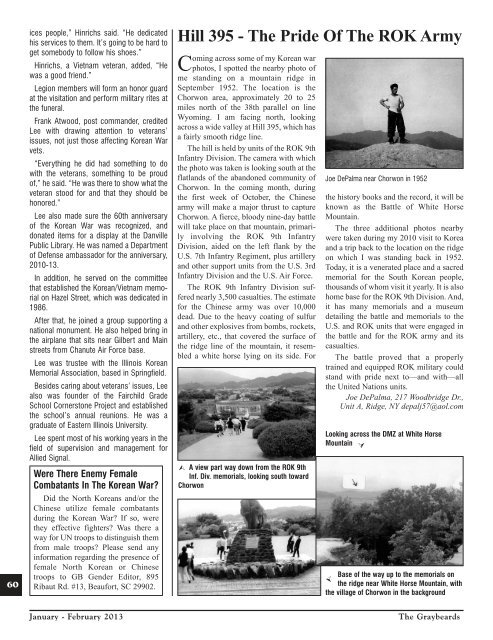Jan/Feb 2013 - Korean War Veterans Association
Jan/Feb 2013 - Korean War Veterans Association
Jan/Feb 2013 - Korean War Veterans Association
You also want an ePaper? Increase the reach of your titles
YUMPU automatically turns print PDFs into web optimized ePapers that Google loves.
60<br />
ices people,” Hinrichs said. “He dedicated<br />
his services to them. It’s going to be hard to<br />
get somebody to follow his shoes.”<br />
Hinrichs, a Vietnam veteran, added, “He<br />
was a good friend.”<br />
Legion members will form an honor guard<br />
at the visitation and perform military rites at<br />
the funeral.<br />
Frank Atwood, post commander, credited<br />
Lee with drawing attention to veterans’<br />
issues, not just those affecting <strong>Korean</strong> <strong>War</strong><br />
vets.<br />
“Everything he did had something to do<br />
with the veterans, something to be proud<br />
of,” he said. “He was there to show what the<br />
veteran stood for and that they should be<br />
honored.”<br />
Lee also made sure the 60th anniversary<br />
of the <strong>Korean</strong> <strong>War</strong> was recognized, and<br />
donated items for a display at the Danville<br />
Public Library. He was named a Department<br />
of Defense ambassador for the anniversary,<br />
2010-13.<br />
In addition, he served on the committee<br />
that established the <strong>Korean</strong>/Vietnam memorial<br />
on Hazel Street, which was dedicated in<br />
1986.<br />
After that, he joined a group supporting a<br />
national monument. He also helped bring in<br />
the airplane that sits near Gilbert and Main<br />
streets from Chanute Air Force base.<br />
Lee was trustee with the Illinois <strong>Korean</strong><br />
Memorial <strong>Association</strong>, based in Springfield.<br />
Besides caring about veterans’ issues, Lee<br />
also was founder of the Fairchild Grade<br />
School Cornerstone Project and established<br />
the school’s annual reunions. He was a<br />
graduate of Eastern Illinois University.<br />
Lee spent most of his working years in the<br />
field of supervision and management for<br />
Allied Signal.<br />
Were There Enemy Female<br />
Combatants In The <strong>Korean</strong> <strong>War</strong>?<br />
Did the North <strong>Korean</strong>s and/or the<br />
Chinese utilize female combatants<br />
during the <strong>Korean</strong> <strong>War</strong>? If so, were<br />
they effective fighters? Was there a<br />
way for UN troops to distinguish them<br />
from male troops? Please send any<br />
information regarding the presence of<br />
female North <strong>Korean</strong> or Chinese<br />
troops to GB Gender Editor, 895<br />
Ribaut Rd. #13, Beaufort, SC 29902.<br />
Hill 395 - The Pride Of The ROK Army<br />
Coming across some of my <strong>Korean</strong> war<br />
photos, I spotted the nearby photo of<br />
me standing on a mountain ridge in<br />
September 1952. The location is the<br />
Chorwon area, approximately 20 to 25<br />
miles north of the 38th parallel on line<br />
Wyoming. I am facing north, looking<br />
across a wide valley at Hill 395, which has<br />
a fairly smooth ridge line.<br />
The hill is held by units of the ROK 9th<br />
Infantry Division. The camera with which<br />
the photo was taken is looking south at the<br />
flatlands of the abandoned community of<br />
Chorwon. In the coming month, during<br />
the first week of October, the Chinese<br />
army will make a major thrust to capture<br />
Chorwon. A fierce, bloody nine-day battle<br />
will take place on that mountain, primarily<br />
involving the ROK 9th Infantry<br />
Division, aided on the left flank by the<br />
U.S. 7th Infantry Regiment, plus artillery<br />
and other support units from the U.S. 3rd<br />
Infantry Division and the U.S. Air Force.<br />
The ROK 9th Infantry Division suffered<br />
nearly 3,500 casualties. The estimate<br />
for the Chinese army was over 10,000<br />
dead. Due to the heavy coating of sulfur<br />
and other explosives from bombs, rockets,<br />
artillery, etc., that covered the surface of<br />
the ridge line of the mountain, it resembled<br />
a white horse lying on its side. For<br />
Ù A view part way down from the ROK 9th<br />
Inf. Div. memorials, looking south toward<br />
Chorwon<br />
Joe DePalma near Chorwon in 1952<br />
the history books and the record, it will be<br />
known as the Battle of White Horse<br />
Mountain.<br />
The three additional photos nearby<br />
were taken during my 2010 visit to Korea<br />
and a trip back to the location on the ridge<br />
on which I was standing back in 1952.<br />
Today, it is a venerated place and a sacred<br />
memorial for the South <strong>Korean</strong> people,<br />
thousands of whom visit it yearly. It is also<br />
home base for the ROK 9th Division. And,<br />
it has many memorials and a museum<br />
detailing the battle and memorials to the<br />
U.S. and ROK units that were engaged in<br />
the battle and for the ROK army and its<br />
casualties.<br />
The battle proved that a properly<br />
trained and equipped ROK military could<br />
stand with pride next to—and with—all<br />
the United Nations units.<br />
Joe DePalma, 217 Woodbridge Dr.,<br />
Unit A, Ridge, NY depalj57@aol.com<br />
Looking across the DMZ at White Horse<br />
Mountain<br />
Ù<br />
Base of the way up to the memorials on<br />
the ridge near White Horse Mountain, with<br />
the village of Chorwon in the background<br />
Ù<br />
<strong>Jan</strong>uary - <strong>Feb</strong>ruary <strong>2013</strong><br />
The Graybeards

















